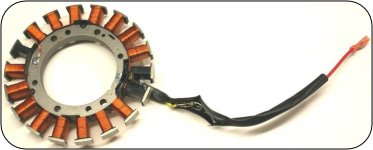I have a SCAG 52" walk-behind, hydraulic drive with a Kawasaki FS600V engine and the electric clutch stopped working. I checked the voltage at the wire that I assumed was the output from the voltage regulator and at idle it's outputting 1.7vdc and at full throttle, its putting out about 2.1vdc. So my assumption is the voltage regulator is bad. I took the engine cover off to identify it for a replacement and...there's no voltage regulator. There is a small wire attached to a spade connector on each coil, they're spliced together and a single wire goes to the mower harness (via a bullet connector). This engine also does not appear to have a stator, rather has a simple magneto. There is a single wire coming from under the flywheel, but my understanding is stators have 2 (or 3) wires.
Am I correct in that there is a diode in each coil, and the output from these diodes is the DC voltage used to power the electric clutch? I have replacement coils on order, but I'm curious if there's something else I should be looking it?
Am I correct in that there is a diode in each coil, and the output from these diodes is the DC voltage used to power the electric clutch? I have replacement coils on order, but I'm curious if there's something else I should be looking it?

